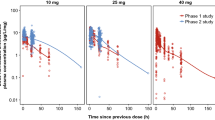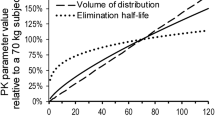Abstract
An exaggerated inflammatory response is responsible for the decline of lung function in patients with cystic fibrosis (CF). Ibuprofen is a potent anti-inflammatory agent that demonstrates inhibition of neutrophil activity in vitro at concentrations between 50 and 100 mg/L, whereas lower concentrations result in an increase in inflammatory mediators. Significant decline in the rate of deterioration of pulmonary function and increased nutritional status were observed in children with CF who were administered long-term high-dosage ibuprofen therapy.
As with many other drugs, CF patients appear to exhibit altered pharmacokinetics of ibuprofen (reduced bioavailability, increased volume of distribution, and more rapid clearance) when compared with healthy controls. However, the absence of studies with intravenous ibuprofen as well as protein binding measurements in patients with CF currently limits the ability to compare the pharmacokinetics with those in other populations. Current studies indicate that there is high interpatient variability in ibuprofen pharmacokinetics among CF patients. Some of this variability can be explained by differences in ibuprofen formulation administered.
Therapeutic drug monitoring of high-dosage ibuprofen therapy is recommended because of the biphasic response to inflammatory mediators demonstrated in vitro as well as the high interpatient variability in pharmacokinetics. Due to the differences in absorption characteristics between ibuprofen formulations, the timing of obtaining blood samples for pharmacokinetic analysis is critical. Maximum a posteriori Bayesian analysis has been shown to provide more accurate and precise estimates of the pharmacokinetic parameters of ibuprofen in children with CF, and may also be a useful tool to further investigate the relationship between measures of drug exposure and efficacy/toxicity outcomes.




Similar content being viewed by others
References
Cystic Fibrosis Foundation. Cystic fibrosis foundation patient registry annual data report 1998. Bethesda (MD): Cystic Fibrosis Foundation, 1998 Sep
Iannuzzi M, Dean M, Drumm M, et al. Isolation of additional polymorphic clones from the cystic fibrosis region, using chromosome jumping from D7S8. Am J Hum Genet 1989; 44(5): 695–703
Kerem B, Rommens J, Buchanan J, et al. Identification of the cystic fibrosis gene: genetic analysis. Science 1989; 245(4922): 1073–89
Davis PB, Drumm M, Konstan MW. Cystic fibrosis. Am J Respir Crit Care Med 1996; 154: 1129–256
Lyczak JB, Cannon CL, Pier GB. Lung infections associated with cystic fibrosis. Clin Microbiol Rev 2002; 15(2): 194–222
Bonfield TL, Panuska JR, Konstan MW, et al. Inflammatory cytokines in cystic fibrosis lungs. Am J Respir Crit Care Med 1995; 152: 2111–8
Bonfield TL, Konstan MW, Berger M. Altered respiratory epithelial cell cytokine production in cystic fibrosis. J Allergy Clin Immunol 1999; 104(1): 72–8
Konstan MW, Berger M. Current understanding of the inflammatory process in cystic fibrosis: onset and etiology. Pediatr Pulmonol 1997; 24: 137–42
Rosenstein BJ, Eigen H. Risks of alternate-day prednisone in patients with cystic fibrosis. Pediatrics 1991; 87(2): 245–6
Insel P. Analgesic-antipyretic and antiinflammatory agents and drugs employed in the treatment of gout. In: Hardman J, Limbird L, Molinoff P, et al., editors. The pharmacological basis of therapeutics. 9th ed. New York: McGraw-Hill, 1996: 617–57
Davies NM. Clinical pharmacokinetics of ibuprofen: the first 30 years. Clin Pharmacokinet 1998; 34(2): 101–54
Kirchheiner J, Meineke I, Freytag G, et al. Enantiospecific effects of cytochrome p450 2c9 amino acid variants on ibuprofen pharmacokinetics and on the inhibition of cyclooxygenases 1 and 2. Clin Pharmacol Ther 2002; 72(1): 62–75
Konstan MW, Vargo KM, Davis PB. Ibuprofen attenuates the inflammatory response to Pseudomonas aeruginosa in a rat model of chronic pulmonary infection. Am Rev Respir Dis 1990; 141: 186–92
Konstan MW, Byard PJ, Hoppel CL, et al. Effect of high-dose ibuprofen in patients with cystic fibrosis. N Engl J Med 1995; 332(13): 848–54
Konstan MW, Krenicky JE, Finney MR, et al. Effect of ibuprofen on neutrophil migration in vivo in cystic fibrosis and healthy subjects. J Pharmacol Exp Ther 2003; 306: 1086–91
Lockwood GF, Albert KS, Szpunar GJ, et al. Pharmacokinetics of ibuprofen in man. III: plasma protein binding. J Pharmacokinet Biopharm 1983; 11(5): 469–82
Lockwood GF, Albert KS, Gillespie WR, et al. Pharmacokinetics of ibuprofen in man. I: free and total area/dose relationships. Clin Pharmacol Ther 1983; 34(1): 97–103
Lee EJ, Willliams K, Day R, et al. Stereoselective disposition of ibuprofen enantiomers in man. Br J Clin Pharmacol 1985; 19: 669–74
Tan SC, Patel BK, Jackson SHD, et al. Stereoselectivity of ibuprofen metabolism and pharmacokinetics following the administration of the racemate to healthy volunteers. Xenobiotica 2002; 32(8): 683–97
Spino M. Pharmacokinetics of drugs in cystic fibrosis. Clin Rev Allergy 1991; 9(1–2): 169–210
Touw DJ, Vinks AA, Mouton JW, et al. Pharmacokinetic optimisation of antibacterial treatment in patients with cystic fibrosis: current practice and suggestions for future directions. Clin Pharmacokinet 1998; 35(6): 437–59
Rey E, Treluyer J, Pons G. Drug disposition in cystic fibrosis. Clin Pharmacokinet 1998; 35(4): 313–29
Konstan MW, Hoppel CL, Chai B, et al. Ibuprofen in children with cystic fibrosis: pharmacokinetics and adverse effects. J Pediatr 1991; 118: 956–64
Murry DJ, Oermann CM, Ou C, et al. Pharmacokinetics of ibuprofen in patients with cystic fibrosis. Pharmacotherapy 1999; 19(3): 340–5
Rifai N, Sakamoto M, Law T, et al. Use of a rapid hplc assay for determination of pharmacokinetic parameters of ibuprofen in patients with cystic fibrosis. Clin Chem 1996; 42(11): 1812–6
Scott CS, Retsch-Bogart GZ, Kustra RP, et al. The pharmacokinetics of ibuprofen suspension, chewable tablets, and tablets in children with cystic fibrosis. J Pediatr 1999; 134(1): 58–63
Williams R, Chen M, Hauck W. Equivalence approaches. Clin Pharmacol Ther 2002; 72(3): 229–37
Benet LZ, Hoener BA. Changes in plasma protein binding have little clinical relevance. Clin Pharmacol Ther 2002; 71(3): 115–21
Kearns GLP, Crom WRP, Karlson Jr KH, et al. Hepatic drug clearance in patients with mild cystic fibrosis. Clin Pharmacol Ther May 1996; 59(5): 529–40
Dong JQ, Ni L, Scott CS, et al. Pharmacokinetics of ibuprofen enantiomers in children with cystic fibrosis. J Clin Pharmacol 2000; 40(8): 861–8
CF Ibuprofen Laboratory. Questions and answers ibuprofen: information for cystic fibrosis physicians 1995 [online]. Available from URL: http://www.cwru.edu/affil/CFIBUPLAB/physgen.htm [Accessed 2002 Sep 17]
Beringer P, Aminimanizani A, Synold T, et al. Development of population pharmacokinetic models and optimal sampling times for ibuprofen tablet and suspension formulations in children with cystic fibrosis. Ther Drug Monit 2002; 24: 315–21
Bell EA, Grothe R, Zivkovich V, et al. Pyloric channel stricture secondary to high-dose ibuprofen therapy in a patient with cystic fibrosis. Ann Pharmacother 1999; 33: 693–6
Scott CS, Retsch-Bogart GZ, Henry MM. Renal failure and vestibular toxicity in an adolescent with cystic fibrosis receiving gentamicin and standard-dose ibuprofen. Pediatr Pulmonol 2001; 31(4): 314–6
Kimura RE, Dy SA, Uhing MR, et al. The effects of high-dose ibuprofen and pancreatic enzymes on the intestine of the rat. J Pediatr Gastroenterol Nutr 1999; 29(2): 178–83
Feigelson J, Girault F, Pecau Y. Gastro-esophageal reflux and esophagitis in cystic fibrosis. Acta Paediatr Scand 1987; 76(6): 989–90
Forsyth DR, Jayasinghe KSA, Roberts CJC. Do nizatidine and cimetidine interact with ibuprofen? Eur J Clin Pharmacol 1988; 35(1): 85–8
Ochs HR, Greenblatt DJ, Matlis R, et al. Interaction of ibuprofen with the H2 receptor antagonists ranitidine and cimetidine. Clin Pharmacol Ther 1985; 38(6): 648–51
Conrad KA, Mayersohn M, Bliss M. Cimetidine does not alter ibuprofen kinetics after a single dose. Br J Clin Pharmacol 1984; 18(4): 624–6
Acknowledgements
No sources of funding were used to assist in the preparation of this manuscript. The authors have no conflicts of interest that are directly relevant to the content of this manuscript.
Author information
Authors and Affiliations
Corresponding author
Rights and permissions
About this article
Cite this article
Han, E.E., Beringer, P.M., Louie, S.G. et al. Pharmacokinetics of Ibuprofen in Children with Cystic Fibrosis. Clin Pharmacokinet 43, 145–156 (2004). https://doi.org/10.2165/00003088-200443030-00001
Published:
Issue Date:
DOI: https://doi.org/10.2165/00003088-200443030-00001




